 |
 |
|||||||||||||||||||||
|
||||||||||||||||||||||
CURRENT POST-BREEDING, WINTER, AND SPRING STATUS OF BOTTERI’S SPARROW (Peucaea botterii arizonae) IN ARIZONA
Alan Schmierer, PO Box 626, Patagonia, AZ 85624
(All photos taken by the author at his home in Santa Cruz Co., AZ)
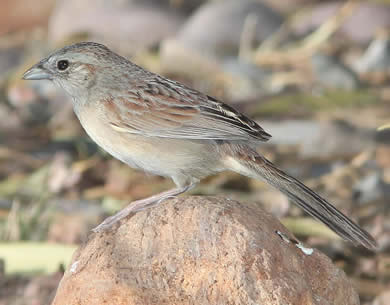 |
| Figure 1: Adult Arizona Botteri’s Sparrow, 9 Mar 2011. (Note that the crown color may look rufous, blackish or a mix at close range depending on lighting and viewing angle and wear.) |
The natural history of Botteri’s Sparrows, including the species summer and winter distributions (Peucaea botterii; Fig. 1), has been extensively studied (Webb and Bock 2012). According to these authors, “In se. Arizona, locally common populations [of Botteri’s Sparrows] are centered on Sonoita Plains, e. Santa Cruz and sw. Cochise Cos., between Santa Rita and Huachuca Mountains; current range limits are Buenos Aires National Wildlife Refuge, Pima Co., to west; Pinery Creek se. of Dos Cabezas, Cochise Co., to north; and Hay Hollow Wash north of MacDonald Peak, 10 km west of entrance to Guadalupe Canyon, Cochise Co., to east” (Phillips et al. 1964, Monson and Phillips 1981, Webb 1985, Tucson Audubon Society 1995; Figs. 2 and 3).
Most bird guides and other references suggest that “Arizona” Botteri’s Sparrows (P. b. arizonae) withdraw south well into Mexico after the breeding season and do not return to Southeast Arizona until late spring (Webb and Bock 2012). However, in one recent reference several “accidental” winter records are listed (Tucson Audubon Society 2011). Furthermore, evidence by the author and other local birders suggests that in recent years this species lingers later into the fall, that at least some sparrows remain on or near their breeding grounds over the winter, and that their return in the spring may be earlier than had been previously published. The objective of this article is to review these winter and “out of season” records and to discuss possible explanations/implications of the findings.
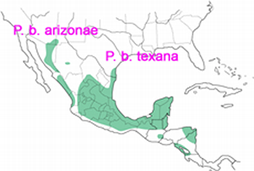 |
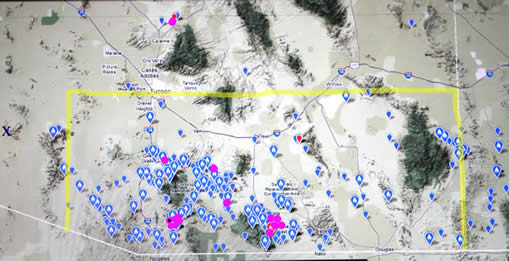 |
| Figure 2: General distribution of Botteri’s Sparrow, showing two subspecies known in USA. (Map modified from and used with permission of: Birds of North America Online http:/bna.birds.cornell.edu/bna, maintained by the Cornell Lab Ornithology.) |
Figure 3: eBird map of reports containing Botteri’s Sparrows. Yellow shows west-north-east limits as described in BNA account for Arizona (Webb & Bock 2012). Pink dots show approximate locations of winter reports. Pink dot with black center is author’s home location. Image modified from and used with permission of eBird [www.ebird.org], and created 15 October 2012. |
PRIOR PUBLISHED ARRIVAL/DEPARTURE DATA
A survey of published literature provides the following sampling of information on the migratory pattern and winter occurrence of Botteri’s Sparrows in the Southwest United States and Mexico.
The greatest wave of spring migrants arrives in se. Arizona during the third week of May, before grasses exhibit new growth; earliest arrival recorded 1 May (Webb 1985). In one study Botteri’s Sparrows arrived at the study site (south of Sonoita) between late April and late May of each year (Jones and Bock 2005).
Birds withdraw from northern areas in September – October and the latest documentation of species in Arizona is on 7 October (Phillips et al. 1964). “…So far as we know, is absent from Arizona and New Mexico in winter. I’ve never seen one there in mid-winter, and I don’t believe that any of the extensive grassland sparrow banding operations have turned up any in mid-winter either…” (Kaufman 2005). In Mexico, “Resident in much of range, but migratory in northern Mexico (withdrawing south Sep/Oct - Apr/May) and probably locally elsewhere” (Howell and Webb 1995).
The bar graph in the most recent edition of Tucson Audubon Society’s Finding Birds in Southeast Arizona (2011) shows that the species is “casual” from the second week of April and then “rare” for the first week of May, becoming “uncommon” from second week of May though late June, “common” through mid-September, “uncommon” again for the latter half of September, and “rare” for the first week of October. In addition, this publication shows several “accidental” sightings, one each for mid-October, late October, late January, and early March (Tucson Audubon Society 2011). These “accidental” dots were added to the prior edition, but the graph was otherwise unchanged from 2007 (Tucson Audubon Society 2007).
To complement this information, the author reviewed reported sightings as reflected in eBird, Christmas Bird Counts (CBCs), the Arizona/New Mexico birding listserv archives, and in recent Arizona Field Ornithologists Seasonal Reports. In 2000 the late date appears to have been October 1. This changed little through 2012. The spring early date in 2001 appears to be 26 April. In 2006 this was 17 April. In 2007 it was 10 April, with numerous reports just after that date. In 2008 and 2009 the dates were similar, but in 2010 the date was pushed back to 4 April. In the winter of 2010-2011 there were reports for December and January, and a late winter/early spring report on 10 March. The sources show a single isolated Botteri’s Sparrow report in December of 1999 from Cochise County, then none until the winter of 2010-2011 when they were reported from both Cochise and Santa Cruz counties in December, January, and March. The number of reported sightings increased in the winter of 2011-2012 to include one in early March west of Oracle in Pinal County, and increased even more in the winter of 2012-2013. Thus, to date the author found at least 12 winter reports of at least 14 birds (Appendix 1).
 |
 |
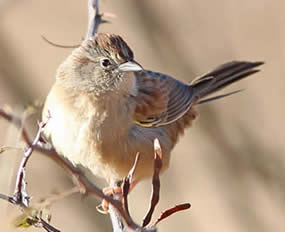 |
| Figure 4: Botteri’s Sparrow, 12 May 2011. | Figure 5: Immature Botteri’s Sparrow, 21 Oct 2011 | Figure 6: Adult Botteri’s Sparrow in winter, 17 Dec 2012. |
AUTHOR’S OBSERVATIONS
All observations in Table 1, except where noted, were made by the author at his residence, located on Circulo Montana, Patagonia Lake Ranch Estates, Santa Cruz County, AZ (Figs. 4-6). This is located between State Route 82 and Patagonia Lake State Park, on a ridge top at about 4200 ft (1280 m) elevation (GPS: 31.46584 / -110.85742 degrees). The habitat consists of rolling grasslands with somewhat widely scattered mesquite (Prosopis sp.), ocotillo (Fouquieria splendens) and patches of low thorny shrubs. The area is lightly to moderately (and rather episodically) grazed by cattle and horses. There are scattered patches of relatively undisturbed grasses. The land rather steeply slopes on two sides of the property (Figs. 7 and 8). Most observations of non-breeding birds on the property were made at an area of flat gravel immediately adjacent to a steep, un-mowed grassy slope, referred to as the “feeding area” in the data (seen in Fig. 8). The preferred portion of a mixed wild bird seed product consumed appeared to be millet (Figs. 9 and 10), but one bird did consume milo on at least one occasion. Observations started roughly just after the author moved to this house in the summer of 2010.
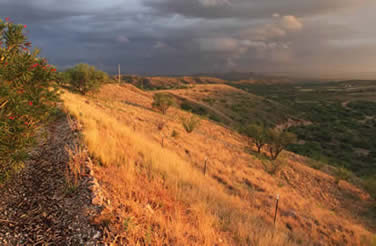 |
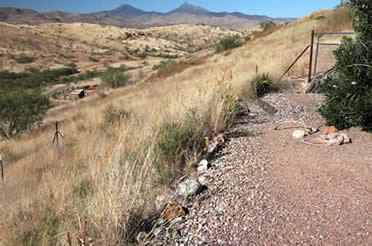 |
|
| Figure 7: Feeding area at author’s house; in gravel at left side of photo (looking south) | Figure 8: Feeding area at author’s house; in gravel at far end of photo (looking north) | |
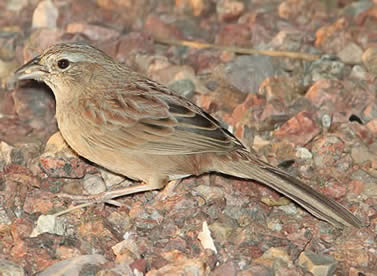 |
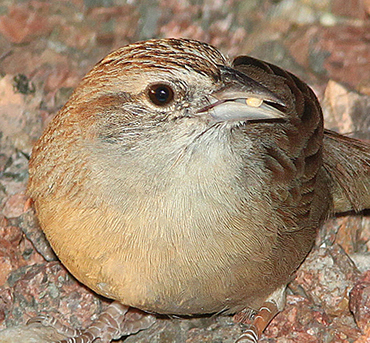 |
|
| Figure 9: Botteri’s Sparrow eating millet, 24 Mar 2011 | Figure 10: Botteri’s Sparrow eating millet, 24 Mar 2011 |
| Table 1. Botteri’s Sparrow observations by the author at his home, except where noted, at or near Patagonia Lake Ranch Estates, Santa Cruz Co., AZ, 2010-2012. |
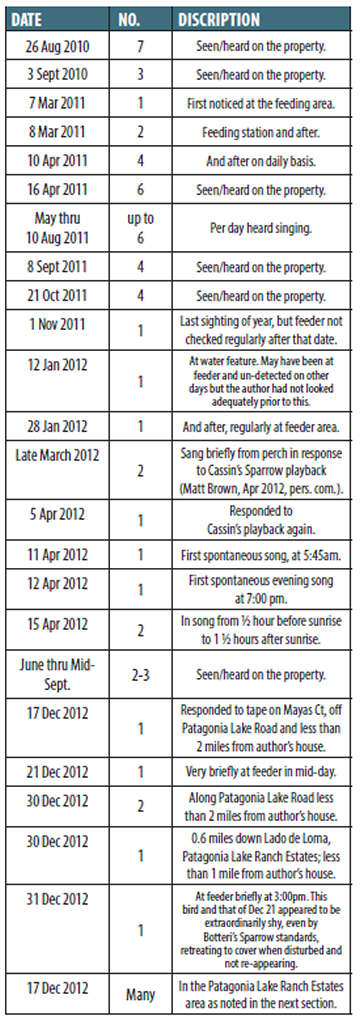 |
JANUARY 2013 SURVEY OF PATAGONIA LAKES RANCH ESTATES
Having seen several Botteri’s Sparrows in the Patagonia Lake Ranch Estates area in late December 2012, the author decided to check the area more systematically. Starting at sunrise on the mornings of 6, 7, and 8 January he surveyed most of the established roads in the development, resulting in finding Botteri’s Sparrows at 14 locations (17 birds; Fig. 11). The methodology of the study was as follows.
 |
| Figure 11: Adult Botteri’s Sparrow in winter, 6 Jan 2013 |
The survey was a modified and informal point count, covering approximately 12.2 mi (19.7 km), i.e., about 90 percent of the roads within the development. Of this distance, approximately 9.70 mi (15.6 km) were from a car and approximately 2.6 mi (4.2 km) were on foot. All roads were within a rectangular area of 4.25 sq mi (6.84 sq km). The Patagonia Lake Ranch estates property is mostly bordered by private working ranch land and state lands, both of which are grazed rather heavily.
Stops were made approximately every 300 ft (91 m) while on foot; stops while driving varied widely from 300-1650 ft (91-503 m) (due to safety issues, wanting an exposed vista in which to play recordings and avoiding areas thought by the author to be poor habitat due to houses, mowed lots, and open floodplain areas). At each stop a recording of Arizona Botteri’s Sparrow was played, often from the car window. The duration at each location was at least 30 seconds, but varied up to 90 seconds where the vista was wide and/or deep. A total of about 10 hours was expended over three mornings.
The response to playback was generally very rapid. With positive responses the sparrows would just appear (“materialize” comes to mind), with only one bird seen flying in from any distance. Each bird then responded with insistent high frequency call notes and assumed a defensive posture, with tail cocked and crown feathers raised. All responses were made from perches above the grass-top level, perched from about 3-9 ft (1-3 m) up in substantial mesquites or taller bushes. Even at close range and being vocal birds were often hard to locate, perhaps, based on the author’s experience, due to the difficulty in locating the direction of high frequency notes in general. The call notes responses lasted as long as playback continued, plus several minutes. Most birds approached within 10-15 ft (3-5 m) and were not shy. Two exceptions were for two birds that popped up at a distance of over 100 ft (30 m). Several birds had been detected by the author in late December at the same locations. Of interest, other sparrows responded to the Botteri’s Sparrow song playback. These included four Cassin’s (Peucaea cassinii), three Rufous-crowned (Aimophila ruficeps) and two Grasshopper Sparrows (Ammodramus savannarum).
FEBRUARY 2013 SURVEY OF PATAGONIA LAKES RANCH ESTATES
A short follow-up survey was done by the author on 5 February 2013 as follows: Starting at 0745 hours, walked from the junction of Patagonia Lake Road and Circulo Montana (paved end) west along Circulo Montana to the junction with Via Escalones, with side trips part way down Roseta Ct and Vista Way, for a total of 1.2 mi (2 km). Botteri’s Sparrow song recording was played approximately every 150 ft (50 m) for at least four song repeats each. Survey ended at 0930 hours. Seven Botteri’s Sparrows responded at six locations along the route.
DATA SUMMARY AND NOTES
FALL: On-line observations from eBird, from the AZ/NM birding listserv and from sources other than the author generally show that Arizona Botteri’s Sparrows become rare during the first week of October. Sightings by the author show at least four birds still present on 21 October 2011 and a single bird still present on 1 November 2011.
WINTER: No observations prior to December 1999. Then CBC data show reliable winter reports in 1999, 2010, and 2011 (two separate CBCs). The birds described in the December 2010 and 2011 CBCs were relocated on at least one date after the initial sighting (Robert Behrstock, 25 October 2012, pers. com.) demonstrating some site fidelity. Combining the CBC data with other reporting sources there appears to have been at least three reports in the winter of 2010-2011, from Cochise and Santa Cruz counties. There were nine reports in the winter of 2011-2012, representing Cochise, Pinal, and Santa Cruz counties. In addition, the author had sightings on 12 January 2012 and then, after 28 January 2012, sightings at the feeder daily. There were five other reports in the winter of 2012-2013, plus several by the author, all in response to song playback. The author’s 6-8 January 2013 survey of the Patagonia Lake Ranch Estates area produced sightings of 17 birds at 14 nearby locations, with all birds demonstrating apparent territorial behavior. A second shorter survey in the same area on 5 February 2013 revealed seven birds at six locations.
SPRING: The on-line data from eBird and AZ/NM birding listserv show April sightings starting in 2006. In 2006 the early date was 17 April. In 2007, 2008, and 2009 it was 10 April. In 2010 it was 4 April. In 2011 it was 11 April. In 2011 the author had four birds on 10 April and after, and six birds starting on 16 April. In 2012 it was 2 April, but was not reported regularly until 17 April.
DIET: Observations made at the author’s feeder indicated that the birds generally consumed only the millet component
of the mixed seed presented. They were only once observed to consume milo seeds and were never observed consuming
sunflower seeds.
RANGE: The eBird map used here in Fig. 3 suggests that the breeding range of the Arizona Botteri’s Sparrow has expanded since the last Birds of North American Online account. The eBird map shows only isolated sightings west and north of that range description, but a substantial number of sightings east into the panhandle of New Mexico.
POTENTIAL FACTORS AFFECTING PRESENCE AND DETECTION
Because the changes in the post-breeding, winter, and spring status of the Arizona Botteri’s Sparrow noted above are generally quite recent, only more time and observations will confirm the degree and permanence of these changes. Some factors that might be considered in the discussion of potential status change, more or less in the order of their likely importance, are as follows:
- Populations of Botteri’s Sparrows, especially at the northern distributional limits, have receded and expanded in Arizona following local disturbances in grassland habitats. “Sacaton, where Botteri’s Sparrow is most abundant, is geographically restricted and declined dramatically in quality and extent during twentieth century due to farming, mowing, water diversion, overgrazing and trampling by fenced cattle, burning, flood channelization, and human settlement. Botteri’s Sparrows were not detected in Arizona between 1903 and 1932” (Webb and Bock, 2012). Subsequently “… African exotic grasses continue to spread rapidly and widely in the Southwest, especially in grazed areas where they form much taller and denser stands than remaining native upland grasslands” (Anable et al. 1992, Roundy and Biedenbender 1995, Biedenbender and Roundy 1996). Recently fledged Botteri’s Sparrows are unable to fly and are dependent upon their parents for food and protection for up to five weeks (Webb and Bock 1996). In turn, this introduction and spread of lovegrasses (Eragrostis lehmaniana and E. curvula)“…apparently [is] providing Botteri’s Sparrows with an ecological opportunity, perhaps even facilitating return to their regional abundance …” (Jones and Bock 2005).
- The winter sightings were all in areas and habitats where the species breeds regularly.
- Recording playback devices are being used more frequently by more observers. Most of the winter observations, other than those at the author’s feeder, were of birds responding to song playback. This method of detection likely has contributed to at least some of the apparent increase in sightings of the species, although researchers had failed to detect them by this method in prior studies (Rick Bowers, pers. com.; Elizabeth Webb, pers. com.). The author’s observations during winter at the feeder were all of birds on the ground. Only when playback was used, as observed rather clearly in the survey, or when spontaneous singing began in the spring did birds perch on vegetation and fences. Of interest, several early-season observations refer to birds responding to the playing of recordings of Cassin’s Sparrow song.
- There is a notable tendency for the average birder to seek a species at a time and place where others have reported it,
thus one report often begets another. This phenomenon is clear from reviewing the AZ/NM birding listserv archives and from personal communication with several of those reporting sightings. - Similarly, finding these birds through “enhanced effort” may explain why most prior early winter reports were during CBC’s, when more people are out in more places and expending more effort than in a normal winter birding day.
- The number of eBird users and the volume of data have greatly increased in recent years. About half of the above observations were found exclusively through the eBird data files.
- Most of the author’s winter detections were at a feeding area devoid of any plant life, thus with no place for the birds to hide. Most observations were made after sundown, often only with barely enough light to identify the birds even as close as 20 ft (6 m) away. The author presumes that most persons seeking the sparrows do not have this setting at their disposal. The general increase in the number of bird feeders is a possible factor in the increase in over-wintering, but is likely not a major factor because in the author’s experience sparrows fed only briefly each day at this source.
- Identifying non-vocalizing Botteri’s Sparrows and in particular separating them from Cassin’s Sparrows can be difficult. It is possible that inexperienced birders may over- or under-count this species for this reason. This is particularly relevant to potential CBC observations, given the limited abilities of many CBC observers.
- This correspondence from Rick Bowers (30 June 2012) is of interest: “I’m guessing that you have not seen any of your Botteri’s fly in winter? [The author has only observed brief flight, and only in response to playback.] I’m thinking that they have not been recorded often in winter because they go into “mouse mode” in winter and only fly if in real danger. Five-striped Sparrows (Amphispiza quinquestriata) do this and were thought to leave the state just as Botteri’s were until Scott Mills got a bunch of graduate students to brave the thorn-covered hillsides that Five-striped occur on in summer and was able to find several birds skulking along the ground. They refused to flush no matter how close people got to them. Cassin’s Sparrows do much the same thing in winter but are more apt to fly if pushed hard by people or predators. I wrote a note many years ago about burrow use by Cassin’s and Black-throated Sparrows (Amphispiza bilineata) as a way to avoid predators ...” (Bowers and Dunning 1985).
CONCLUSIONS
Botteri’s Sparrows in Arizona likely linger later into the fall than previously thought and are probably present in small and decreasing numbers through October. Furthermore, based on at least three consecutive winters, the data suggest that Botteri’s Sparrows are also present in small numbers throughout the winter in at least some of their breeding locations. These winter birds appear to have established a territory. Although they may be poorly detected, their numbers likely increase in the spring to at least an “uncommon” level by mid-April (Table 2). Detections in any season when the species is not actively territorial (singing or reacting to playbacks) is often extraordinarily difficult, thus making assessment of numbers challenging.
The reason for the increase in recent winter season detection records is unclear. This increase may represent a real change or a fluctuation in occurrence due to unknown factors, the most likely of which is changes in grassland habitat conditions, or perhaps less likely, an effect of climate change. The fact that there have been multiple sightings over the past three successive winters suggests that this is a real change and not an irruptive event.
The species may have been present in small numbers in other recent winters but has remained undetected. With modern knowledge, manpower, and technology, plus the greater expectation of finding them, we are now detecting them more often despite the fact that they may be in winter “mouse mode”. In addition, the advent and growth of eBird reporting has increased the potential number of reports in any season.
| TABLE 2: Abundance chart based on Botteri’s Sparrow sightings noted in this article |
 |
FURTHER STUDY
The author urges birders not only to be aware that Arizona Botteri’s Sparrows may be present in the winter, but to report all unseasonal observations of Botteri’s Sparrows to the AZFO regional compiler and enter all observations into the eBird data base. Organized searches/surveys of known Botteri’s Sparrow breeding areas from October through the winter and into early April would be especially helpful in determining the true seasonal status of this sparrow in the state. In addition, the author would urge those individuals living in Botteri’s Sparrow breeding habitat and who feed birds in the winter to monitor the ground feeding area near first and last light in the day for their presence. A banding study to determine if wintering birds are on their breeding territory or if they have established a separate wintering territory would be informative.
ACKNOWLEDGMENTS
Thanks to Pierre Deviche for his encouragement and editorial assistance; to Betsy Webb and Rick Bowers for their enthusiastic email comments about their experiences with the sparrows in winter; and to Troy Corman for help in finalizing the manuscript. Thanks to all of the observers who took the time to respond to my email requests for sighting details, and a special thanks to those who take the extra effort to enter sightings into eBird, which makes research immeasurably easier.
REFERENCES
Anable, M. E., M. P. McClaren, and G. B. Ruyle. 1992. Spread of introduced lovegrass (Eragrostis lehmanniana) in Southern Arizona. Biological Conservation 61:181-188.
Biedenbender, S. H., and B. A. Roundy. 1996. Establishment of native semidesert grasses into existing stands of Eragrostis lehmanniana in Southeastern Arizona. Restoration Ecology 4:155–162.
Bowers Jr., R and Dunning Jr., J. 1985. Predator avoidance through burrow use by Cassin’s and Black-throated Sparrows. Western Birds 16:51.
eBird. 2012. eBird: An online database of bird distribution and abundance [web application]. eBird, Ithaca, New York.
Available: http://www.ebird.org. (Accessed: 20 September 2012).
Howell, S. N. G. and S. Webb. 1995. A Guide to the Birds of Mexico and Northern Central America. Oxford Univ. Press, Oxford.
Jones, Z. and C. Bock. 2005. The Botteri’s Sparrow and exotic Arizona grasslands: An ecological trap or habitat regained? The Condor, 107(4):731-741. Cooper Ornithological Society.
Kaufman, K. 2005. In birdwg05 listserv (23 Nov 2005).
Monson, G. and A. R. Phillips. 1981. Annotated Checklist of the Birds of Arizona. Univ. of Arizona Press, Tucson.
Phillips, A. R., J. T. Marshall, Jr., and G. Monson. 1964. The Birds of Arizona. Univ. of Arizona Press, Tucson.
Roundy, B. A., and S. H. Biedenbender. 1995. Revegetation in the Desert Grassland, p. 265–303. In M. P. McClaran and T. R. Van Devender [EDS.], The desert grassland. University of Arizona Press, Tucson, AZ.
Tucson Audubon Society. 1995. Davis and Russell’s Finding Birds in Southeast Arizona. Tucson Audubon Society, Tucson, AZ.
Tucson Audubon Society. 2007. Tucson Audubon Society’s Finding Birds in Southeast Arizona. Tucson Audubon Society, Tucson, AZ.
Tucson Audubon Society. 2011. Tucson Audubon Society’s Finding Birds in Southeast Arizona. Tucson Audubon Society, Tucson, AZ.
Webb, E. A. 1985. Distribution, habitat and breeding biology of the Botteri’s Sparrow (Aimophila botterii arizonae). Master’s Thesis. Univ. of Colorado, Boulder.
Webb, E. A. and C. E. Bock. 2012. Botteri’s Sparrow (Peucaea botterii), The Birds of North America Online (A. Poole, Ed.). Ithaca: Cornell Lab of Ornithology; Retrieved from the Birds of North America Online:
http://bna.birds.cornell.edu/bna
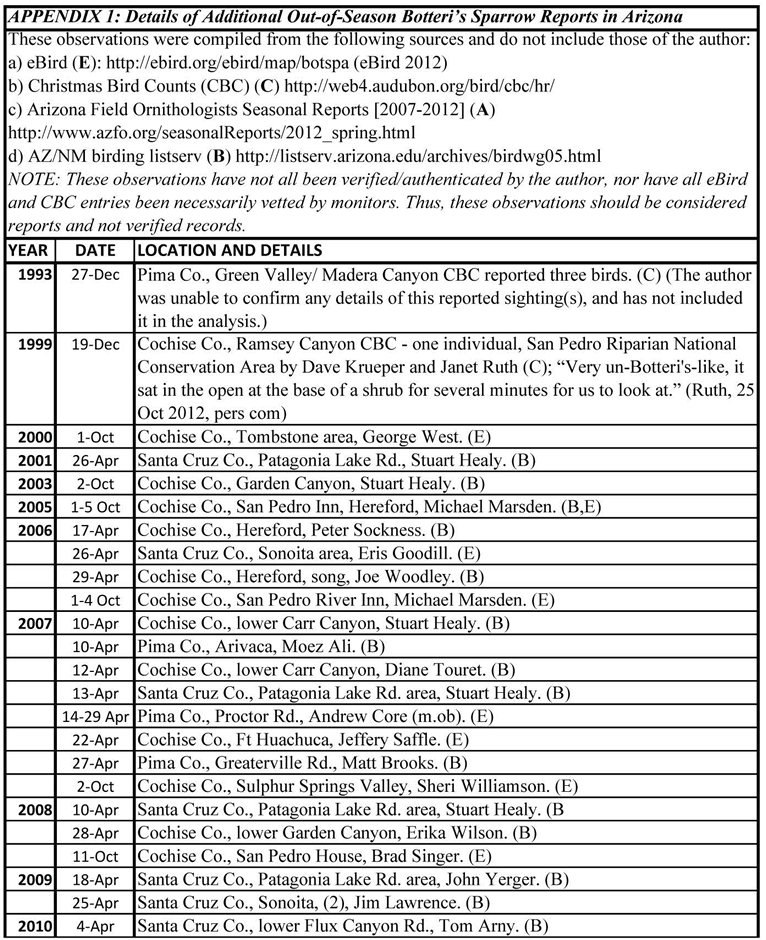 |
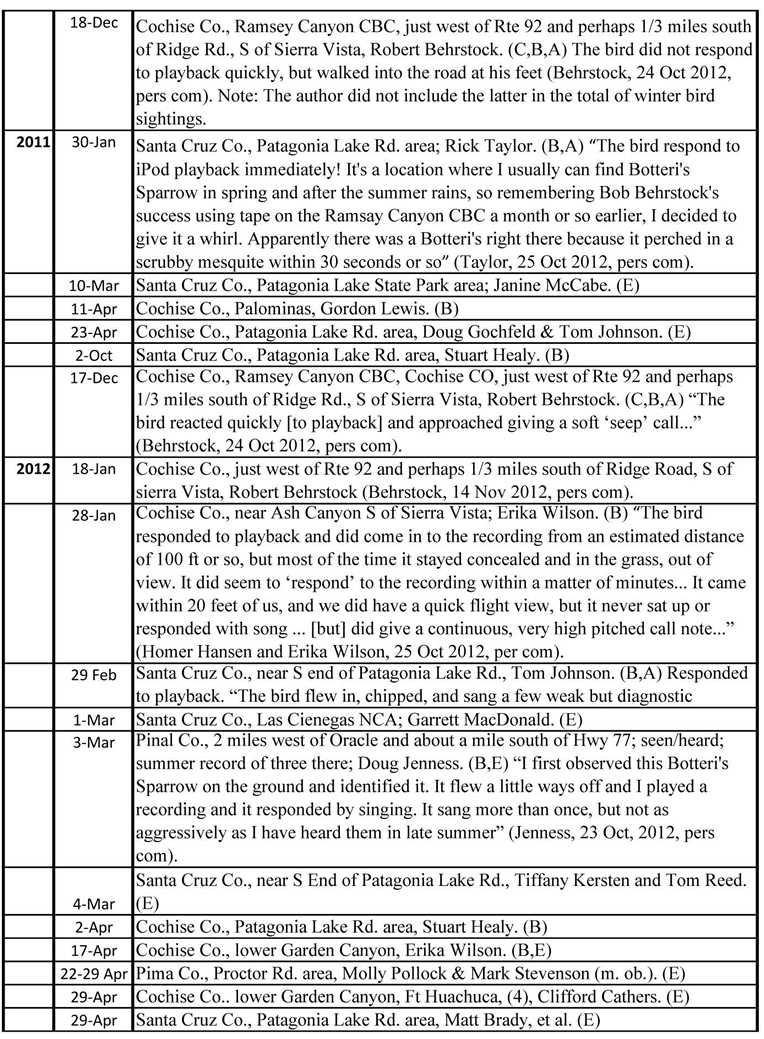 |
 |
Accepted 15 March 2013
|
©2005 |
HOME | | | REPORT SIGHTINGS | | | PHOTOS | | | BIRDING | | | JOURNAL | | | ABOUT US | | | CHECKLISTS | | | AZ BIRD COMMITTEE | | | EVENTS | | | LINKS |